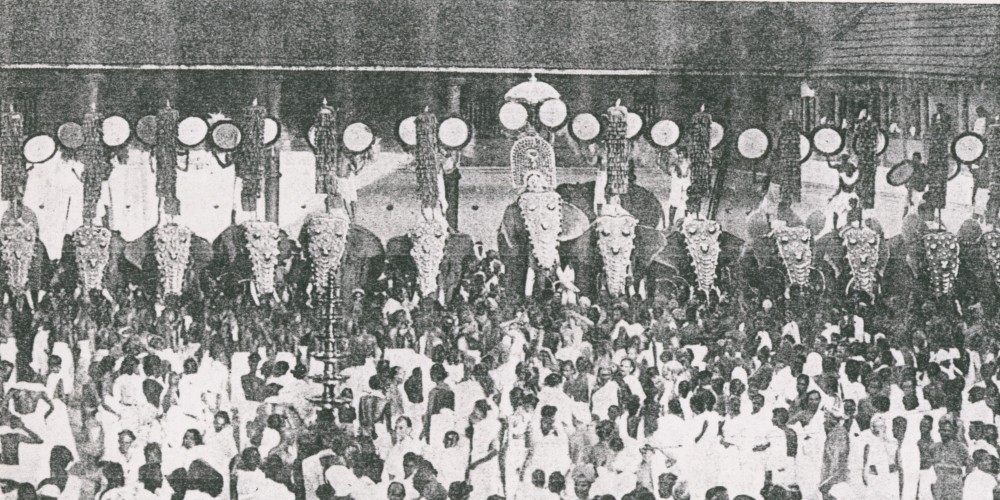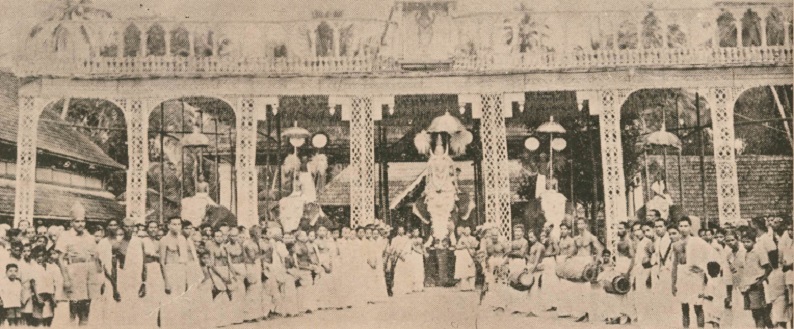Mātangalīla, the magnum opus by Nīlakanta dates back a few centuries, Malayalam Era (Kollavarsham) 761 according to the interpretation of the text by Cheruvalli Narayanan Namboothiri and an English translation of the text by Frank Edgerton; Pālakāpyam, the one that formed basis for the former however was written much earlier, although the exact date is unknown.
There are anecdotes and arguments raised with regard to the historicity of elephants’ association/or their use with/in temples and other religious establishments, which is the central part of the Elephant in the Room, although a detailed attempt at arriving at more reliable estimates of the period is lacking.
Neither Mātangalīla nor Pālakāpyam does mention about use of elephants in temples or for religious practices, and both these texts that deal with good and bad signs of an elephant (śuba-aśuba lakshana:), musth, treatment and daily care, trade and price determination, talk of elephants as vehicles for the kings (…sa: gajō rājavāhana: for instance).
The earliest use of elephants in temples of Tamil Nadu mentioned in historical sources similarly state that they were primarily used as draught animals, to carry water to the sanctums and also for transportation.
However in Kerala, the scenario is different, even the oldest records available talk about pageantries. The dissection of the current state of elephant management in the state of Kerala is not complete without understanding the historical relationships and the changes that have followed. It is also important to understand these historical patterns to better unravel the lacunae in welfare and management, which is the immediate question to be addressed. This part of the series will delve more into the past, attempting to throw light on practices of the yore.
Historical accounts on elephants at festivals
The oldest pageantry of caparisoned pachyderms in Kerala is believed to be the Arattupuzha pooram, an annual cultural extravaganza parading tens of elephants (at one point believed to have paraded 108 regularly). Also called the devamela or devasangamam (meeting of the gods and goddesses), the Arattupuzha pooram is ~1400 years old (oldest inscription being in A.D. 583), and is perhaps the oldest in the subcontinent.
However it is still not well known as to when the use of elephants in the processions began. The Thripunithura temple of Cochin Royal Family also have stories to tell of processions as old as a few centuries. Legend talks about Saint Vilwamangalam visiting the temple and watching the majestic pageantry parading 15 elephants.
On investigation of the history of these festivals, records or evidences on use of elephants begin from the 1700s to 1800s, showing that the use of elephants in temples is perhaps ~200-250 years old, although elephants in captivity dates back more than a millennium.
This estimate is also in accordance with the dates mentioned in Aithīhyamāla (garland of legends in its literal sense), a magnum opus that describes legends of erstwhile Kochi, Malabar and Travancore, by writer Kottarathil Sankunni, where he also features the lives of eight legendary tuskers.
Pepita Seth in her book on Guruvayur while mentioning its history also raises the falling-out between the then Maharaja of Cochin and the Zamorin Raja, as early as 1780s, and how the former disagreed to send elephants from his royal stables to the annual festival of Guruvayur. This again is consistent with the earlier dates.
The Cochin State Manual by C Achutha Menon, in a section on elephant capture by the East India Company mentions about the capture of elephants in large numbers from the forests of Cochin for the Imperial Forest Department. Towards latter part of 1890s, the department had 20 elephants under their charge in Cochin region, 8 belonging to the Government and 12 to the Devaswom (the temple management), indicating that the temples did have elephant pageantries back then.
The Malabar Gazetteer similarly talks of elephant captures by Nilambur and Kollengode rajas. A mention about the crescent shaped designs on the nettipattom (headgear part of caparisons) of an elephant in the Aṣṭamiprabhandhā written by Melpathoor Narayana Bhattathiri (1559-1645), could be a potential evidence of elephants in temples as old as late 1500s to early 1600s. What seems, nevertheless, evident and agreed upon by most to a greater extent, is that these pageantries are a reflection of a more feudal era as is evident from the oldest festivals that are more or less associated with princely states and the royal deities.
Practices of yesteryears
From being war machines of Carthaginian era and Mughal days, elephants later became symbols of pride and pomp in the yards of Rajas and Sahibs. In Kerala, particularly, most affluent families of yesteryear had dozens of elephants often caught from their own forestlands, the royal family of Nilambur and Koyappathodi family of Calicut being classic exemplars.
While emphasis was on the display of these beauties, welfare was never overlooked. In the days of yore, emphasis was laid on elephant — mahout relationships that often lasted ages, till the death of either of the two, unlike today. Of all the various such examples, the most celebrated one is that of the legendary Guruvayur Keshavan, whose tales are carried by the winds of elephant countries of Kerala even 39 years after his demise, not just because of his qualities, but also because of the bond he had with Achuthan Nair, Mani Nair and several other mahouts. This relationship was in fact even celebrated on big screen by filmmaker Bharatan in his 1977 movie titled after the tusker. Aithīhyamāla, the text mentioned earlier also talks of similar elephant — mahout relationships.
Mātangalīla compares a mahout to the head of a state (Nāgādhyakṣasthu dhīmāna narapati sadr̥śō) stating that a mahout should be loyal to his profession and to his elephant like a king to his subjects, and emphasises on his responsibilities and priorities. Trained in and well aware of elephant behaviour, physiology, and diseases and their treatments, mahouts dealt with most problems back then, even including behavioural or psychological ones. A proper shower of an elephant, for instance, lasted a few hours during which communication between the mahout and the elephant, verbal and tactile, helped in strengthening the relationship.
Hasthyāyurvēda underlines the importance of such long baths from a physiological perspective and how it aids in increasing blood flow and improving health. Elephant management back then was also a collective responsibility, where the owner and the mahout ensured the welfare of the animal unlike what it is today.
Continued in the next part
Disclaimer: The author(s) subscribes only to the viewpoints expressed in this article and not necessarily to the other articles or viewpoints expressed in this magazine.
References-
- Namboothiri, C. N., 2009. Mātangalīla. Arthavedīvyākhyānam. Santha Publishers, Kodungalloor.
- Edgerton, F., The Elephant-lore of the Hindus: The Elephant Sport (Matangalila) of Nilakantha, 1931, reprinted by Motilal Banarsi- dass, New Delhi, 1985
- Seth, P. 2009. Heaven on Earth: The Universe of Kerala’s Guruvayur Temple. Niyogi Books.
- Daniel, J. C.1998. The Asian elephant: a natural history. Natraj Publishers.
Sreedhar Vijayakrishnan is a PhD scholar at the National Institute of Advanced Studies, Bangalore and a Research Affiliate at the Nature Conservation Foundation, Mysore. His research interests are in the area of elephant behaviour and ecology in human-modified landscapes and in conflict situations. He is also interested in understanding the historical and cultural aspects of human – elephant relationships in India, as practiced by generations of mahouts, particularly in Kerala and as portrayed in the literary works of the yore.


